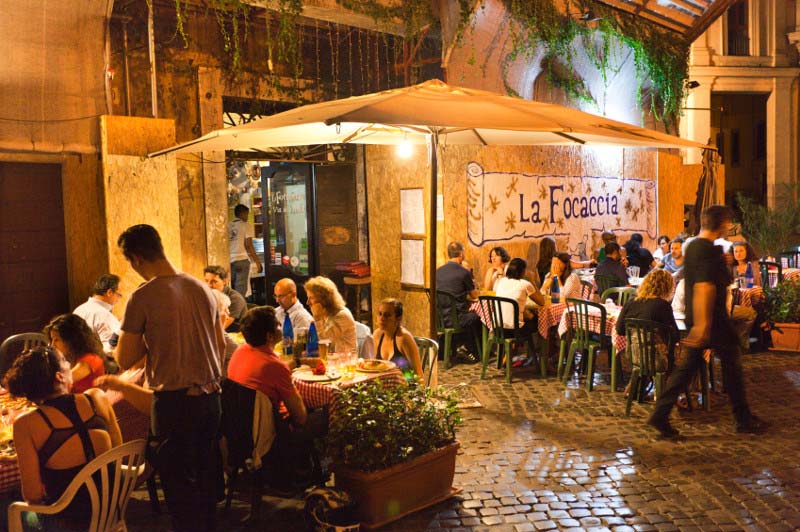#food #Italians #eating
“Eating and drinking go hand in hand in Italy”–Paul Ebeling
Italians take eating and drinking seriously. Ancient Romans made wine and hosted elaborate banquets, which means that Italians have been perfecting the art of the table for more than 2,000 yrs. If you’ve spent any time in Italy, you noticed that there are many unspoken rules about meal times, restaurant etiquette, and the appropriate time of day to drink a cappuccino.
So, before your next trip, study these unofficial rules to follow when eating and drinking in Italy, as follows:
In Italy, the quintessential breakfast is a cappuccino or espresso with a cornetto or other pastry, taken standing up at the bar. You can find cornetti (croissants served plain or filled with jam, cream, or sometimes Nutella) pretty much everywhere, but there are also regional pastries that are absolutely worth trying, like maritozzo (a soft bun split and filled with cream) in Rome, sfogliatella (a seashell-shaped pastry with orange-scented ricotta) in Naples and the Amalfi Coast, and brioche with granita in Sicily.
Italians will drink espresso at any time of day, but a cappuccino is strictly for breakfast. That is because drinking milk after a meal hampers our digestion. If a shot of espresso is too strong for you, try a macchiato (espresso with a dollop of milk) or a caffè lungo (coffee with a larger ratio of water to espresso).
Caffè americano most closely resembles American-style drip coffee, though it’s still made with espresso. In the Summer, when it’s very hot, you can order a caffè freddo (cold, sweetened espresso), a caffè shakerato (like an espresso Martini without the alcohol), or a crema di caffè.
Mealtimes can vary slightly, but Italians typically eat lunch between 1 and 2:30 p.m. and dinner between 8:30 and 10:30 p.m. Many restaurants will open for lunch around 12:30 or 1 p.m. and close the kitchen from 2:30 or 3 p.m. until 7 or 7:30 p.m. Restaurants that serve dinner before 7 p.m. are catering to tourists. In small cities and towns, do not expect to be able to sit down for a late lunch or early dinner. If you are hungry between mealtimes, you can get a sandwich at a bar.
When it comes to Italians cooking, freshness and seasonality are crucial. Though nowadays you can get many fruits and vegetables year-round, Italians know that they’re going to taste better during their peak season. Tomatoes are most flavorful in Summer, while Fall brings squash, Winter is the season for artichokes, and Spring is bursting with green veggies like peas, fava beans, and asparagus. Most restaurants change their menus seasonally or offer seasonal specials in addition to the usual dishes.
Italians cook a lot, so when they go out to eat, they want to eat food that’s as good as or better than the traditional meals they have at home and they can be very critical because they know the proper way to make many dishes served at restaurants.
A lot of emphasis is placed on traditional recipes, both in terms of the ingredients and techniques used to make them. Forget about eating a plate of cacio e pepe with parmigiano as the recipe calls for pecorino romano. And do not think about putting cream in a carbonara as it is made with guanciale, eggs, freshly cracked black pepper, and pecorino. Anything else would be sacrilege.
Similarly, Italian cuisine is regional. It would be rare to see eggplant parmigiana and cotoletta alla milanese on the same menu in Italy. Some dishes like a simple spaghetti with tomato sauce or linguine with clams transcend their origins, but for the most part, menus tend to focus on regional specialties.
In Rome, trattorias serve Roman pastas like carbonara, cacio e pepe, amatriciana, and gricia.
In Tuscany, specialties include pappa al pomodoro and bistecca alla fiorentina.
In Milan, you’ll find risotto alla milanese and cotoletta alla milanese.
One of the best things about traveling in Italy is trying the regional specialties, so don’t hesitate to ask your waiter about the local dishes he or she recommends.
Sure, you can have some parmigiano grated on top of your ragù alla bolognese, but do not ask your waiter to put parmigiano on linguine with clams. They might oblige, but they will be horrified by your gauche manners and lack of taste. Strong cheeses like parmigiano and pecorino cover up the delicate flavors of fish and seafood. Parmigiano is most appropriate when eating pastas with heavy sauces, like ragù.
Roman cuisine is full of dishes with cheese. And if the guest wants more cheese, it should be grated tableside. The best thing is always to have a piece of parmigiano and grate it tableside so you can taste the cheese.
In Italy menus generally start with antipasti (appetizers), primi (pasta, rice, or soup), secondi (main courses, usually meat or fish), contorni (side dishes), and dolci (desserts). And you are not expected to order 4courses every time you sit down at a restaurant.
This kind of menu with antipasto, primo, secondo, contorno is above all for celebrations like weddings because in Italy you’re at the table for 3-4 hrs. The Italian style is to start with an antipasto and then choose a pasta or a main course with a side dish and then end with dessert.
With rare exceptions, taking leftovers home at the end of a meal is not done. However, here’s a little tip: if you want to taste a bunch of dishes without feeling like there’s a brick in your stomach at the end of a meal, you can ask for a mezza porzione (half portion). Not every dish can be served in this way, but many restaurants will make you a half portion of pasta if you ask for it.
Note: Because mealtimes happen over the span of 2-3 hrs in the afternoon and evening, restaurants are not in the business of turning tables. So, it is important to make a reservation, especially at popular spots where there is a high demand and small number of seats.
Also: Italian waiters will not bring you the check until you ask for it. That is because meals are seen as social activities and it would be rude to rush you out while you’re enjoying the company of family or friends. With some exceptions, if you make a reservation at 8:30 p.m., the restaurant’s staff is essentially giving you that table until closing time. If you walk into an Italian restaurant at 7:30 or even 8 p.m. and ask to sit at 1of the many empty tables you see, you might still be turned away because those tables have been reserved.
Eat healthy, Be healthy, Live lively









